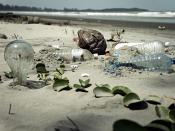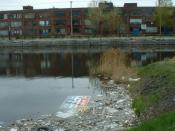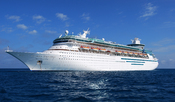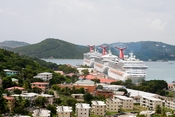Why is pollution still running rampant in our environment? People have seen many of the direct and indirect effects it has on the environment and on them. Are there no effective laws in place to regulate it? Canada has many laws that attempt to stop and regulate pollution. But despite this, Pollution is still a major concern for people around the world and it is still happening. What are Canada's so called enforcement measures and are they effective? Canada has the Canadian Environmental Protection Act (CEPA), which includes an Act called the Ocean Dumping Act, which focuses mainly on the disposal at sea. The disposal at Sea program was implemented to set guidelines and regulations regarding disposal of wastes at Sea. But this Act has many loopholes and weaknesses that need to be addressed in order to secure its effectiveness in protecting the Oceans. One of the issues with this Act is that some forms and sources of Ocean pollution have been overlooked or excluded from the Act.
Monitoring of pollution sites at sea is very difficult as well as the enforcement of these laws have proven to be inefficient at deterring polluting behavior.
What is CEPA?Canada has created laws under CEPA, which is a consolidation of the Environmental Contaminants Act, the Air Quality Act, the Canada Water Act, the Ocean Dumping Act and the Department of the Environment Act. The Canadian Environmental Protection Act, 1999 (CEPA 1999) is an important part of Canada's federal environmental legislation which main goal is to implement tools that would allow for the conservation and sustainability of the environment. CEPA 1999 came into force on March 31, 2000 after it was reviewed by the Parliament. The disposal at Sea program was included in the Act and according to it Disposal at sea is the deliberate disposal of approved substances at sea from ships, aircraft, platforms or other structures.
In this part of the revised Act a new definition of waste was broaden so that materials acceptable for disposal would include: dredged material; fish or other organic waste from fish processing; ships, aircraft, platforms or other structures, once all material that could create floating debris had been removed, provided these substances would not pose a serious obstacle to fishing or navigation; inert, inorganic geological matter (such as sand or rock); uncontaminated organic matter; and bulky metal or concrete substances that did not have a significant adverse effect, other than a physical effect, on the sea or seabed, provided disposal at sea was the only practicable manner of disposing of them and they would not pose a serious obstacle to fishing or navigation.
The Act prohibits the importing, exporting and loading of a substance into a ship for the purpose of disposal in the sea as well as the actual disposal or incineration of a substance at sea, unless the disposal and incineration are done in accordance with a Canadian permit and the substance in question is "waste or other matter". Each year in Canada, two to three million tonnes of material are disposed of at sea under this system of permits that has been in place since 1975.
Disposal of Grey water at seaOne of the weaknesses in the Disposal at Sea Act has been overlooking the impact of "Grey water" in the Ocean. "Grey water" discharge on the marine environment has become a significant concern of some environmental groups in recent years and a focus of the cruise ship industry. "Grey water" is wastewater including galley, laundry, bath and sink water but does not include "black water" or sewage from human waste and medical facility sink drainage.
When untreated, grey water often contains elements of hydrocarbons, oils and greases, metals such as copper, nickel and zinc, fecal coliform bacteria and various other pollutants, which may be hazardous if introduced into the ocean improperly and in substantial volume. Canada has no standards for gray water discharges, so cruise ships freely dump their wastes into the ocean, which approximately is 1.3 million litres of wastewater per day.
Setting and including standards regarding grey water and its disposal in CEPA can address issues regarding cruise dumping. Cruise ships should be made responsible for their own wastes regardless on where they dump. They should be enforced to treat grey water or find better ways to get rid off untreated wastewater. Control should be enforced to assure that this wastewater is not dumped freely as it is being done right now. If regulation regarding disposal of grey water is not respected, cruise companies should be punished or reprimanded with large fines.
United Stated vs. CanadaCompared to the US, Canada's position in this matter is very lax. In the United States Cruise ships have accrued over 60 million dollars in environmental fines over the last five years. Yet, in Canada there have been no fines despite the fact that these same ships visit their waters. Canada should seriously consider strengthening the environmental regulations that govern cruise ships. According to Linda Nowlan of West Coast Environmental Law: "a ship that sails from Seattle to Alaska can't dump sewage in Washington's waters and it can't dump in Alaskan waters. But it can dump raw sewage for most of the thousand kilometres it travels in BC." (The Dominion Vol 2, July 2004)In the Kyoto Protocol, which Canada jumped on board, there is a loophole which benefits cruise ships. Greenhouse gas emissions of international ships are excluded from the national emissions inventories. Bunker fuel emissions of commercial vessels (whether registered as domestic or foreign-flagged), like airplanes, whose "point of departure or point of destination" is outside territorial waters, will find their emissions are not counted.
Over the last three years there has been a 300 percent increase in cruise ship traffic in Victoria, British Columbia. Cruise ships should be made responsible for their waste and create a way to treat this wastes instead of dumping them into the ocean.
Ocean currents.
Another source of waste that is not included in the Act is waste that has not been released into Canadian jurisdiction but waste that have travelled with ocean currents. Dilution of a substance considered damaging to the environment does not completely abate, nor does the waste sit still once it gets to the bottom of the ocean. Thanks to ocean currents these pollutants may travel miles and miles away from the initial disposal area. The issue here is that if a pollutant was dumped in Point A and travelled with ocean currents to Point B, where it can cause serious damage to the environment, who is held responsible or liable for the damages?Since implementing this Act, there has been many changes in the amount of waste dumped into the ocean, but why there is still so much dumping taking place? Even though firms face fines for bad behavior, there is still a lot of illegal dumping taking place. This fines shows that Canada's courts are starting to look more seriously at these crimes, but what good is a fine if you can't catch the offenders? Or even worse when they are repeated offenders. Hundreds of ships illegally dump oil bilge intentionally in Atlantic Canada waters every year. This problem arises mainly because monitoring or surveillance is very hard to achieve.
Because many firms are aware that monitoring ocean dumping is very hard to accomplish, foreign ships enter Canadian waters and illegally dump into the ocean, especially oil. Lately budgets for enforcement and monitoring of environmental laws have been steadily cut, so how should this Act work effectively if it is not monitored as it is supposed to.
The fact that there are firms that reoffend should be addressed as well. It may be that the fines imposed are too low or that the offenders have not been reprehended enough. The only explanation to firms committing the same crime is that Canada is falling short in monitoring and enforcement. Convictions against ships that dump, though, are rare. Even though fines or penalties can theoretically reach more than $1 million, as well as three years in prison, enforcement of this laws are very difficult, especially because the evidence of dumping or proving the source of the dumping is very hard to achieve and takes a lot of time and money.
The way Disposal at sea is monitored and enforced should get a revision and be made tougher; fines should increase so that firms are deterred of trying to illegally disposed substances into the ocean.
Technologies used to monitor and control dumpingTechnology can be used in order to control and monitor ships and deter their dumping at sea. In Canada for example the Federal government is trying to introduce a new plane that would serve as an advantage over ocean-bound polluters in monitoring their dumping. This new plane is called Dash 8, which is outfitted with high-tech surveillance gear which will give crews the ability to monitor the seas with stealth at the peak times when polluting ships dump their wastes in traffic lanes.
This new technology will facilitate the detection of polluters especially at night, when it mostly when polluters dump their waste. As well it is important because as it becomes more widely used and known, the aircraft will act as a significant deterrent to the would-be polluters as it becomes widely known that there is a system in existent that is monitoring them more closely than ever before.
Another feasible technology to control or monitor polluters is by using advanced electronic equipment, such as satellite technology. The use of satellites will likely increase in the future and they will help identify violations in open waters across the world. Tracking information obtained from satellite data may help establish cases for persecution and conviction of ocean polluters. To control and detect pollutant actions at open sea has proven to be extremely difficult given the magnitude of the area involved, the ocean, and the limited resources available for monitoring and surveillance.
Dumping at the International levelAt the international level there must be some entity that should be able to control or set guidelines regarding dumping at Sea. It is very difficult to get everybody on board especially when over 90% of world trade is carried by the international shipping industry. Every ship generates wastes during its operation, whether is transporting cargo or just by operating at sea. The main wastes produced by ships include: oily tank washings or slops, garbage from the crew and cargo residues. Depending on its size, a ship can generate from a few hundreds to more than a thousand tons of waste during its operations.
Ship oil pollution remains mainly routine operational discharges. The prevention of pollution by oil at sea requires ships to reduce their oily discharges at sea. In order to reduce these wastes there must be ports or terminal reception facilities where these ships can release them. These wastes must be kept on board the ships until they reach a port reception facility.
The inadequacy of port waste reception facilities or reception terminals is a significant contributing factor to illegal discharge of oil at sea. That is why the development of such facilities is an important step in the prevention of ocean dumping.
The main focus for controlling ocean dumping should be to develop approaches that would improve the level of transparency and certainty in the way events take place from the moment wastes are generated on board ships and the way they are discharged or delivered to a port reception facility until these wastes are recycled or disposed of. An international standard would provide specification for reception management systems for safe and environmentally friendly facilities. It would encourage best practices and facilitate the selection of port and terminal reception facilities by ships.
In conclusion the Disposal at sea Act serves as a starting point so that it can be develop into an Act that can help protect the sustainability of the oceans. This Act should have included issues that arise from the pollution that Cruise ships leave behind. These ships can pollute the oceans tremendously, and therefore should be taken into consideration. As well there should be clearer standards for pollution that have travelled with Ocean currents, because many hazardous materials can come into Canadian waters and impact the environment. In order for this Act to be effective, there should be stricter rules and monitoring should be a priority as well as the enforcement of these laws. Once a firm has been found liable, harsher fines should be set so that this firm would not even consider breaking the rules again. As well there must be some facilitation for ships in the dumping of wastes with the setting up of terminals or port where they can discharge them. In order to control and monitor our oceans, new technologies must be developed and placed in use so that this task is facilitated and done more efficiently.
Reference:Sea-dumped munitions: An unseen threat http://www.stfx.ca/research/polgov/UnseenThreat.htm Retrieved October 20, 2008Regulatory controls for cruise ship waste for vessels operating in Canadian water http://www.tc.gc.ca/mediaroom/backgrounders/b02-M018.htm Retrieved October 25, 2008U.S. concerned with new Canadian shipping rules in Arctic http://www.dose.ca/news/story.html?id=ddf03f21-1628-4659-aeda-52dfe3635085 Retrieved 26, 2008http://dsp-psd.tpsgc.gc.ca/Collection-R/LoPBdP/BP/bp322-e.htm#B.%20Boundary%20Delimitation%20between%20Adjacent%20States(txt) Retrieved October 29, 2008Yuill , Herbert, and Gorecki Karen. "Cruise control." Dominion July 2004www.basel.int/meetings/cop/cop9/docs/i39e.docUNEP International conference on the environmentally sound management of wastes generated at sea, Marseille, 24-26 November 2008High-tech plane aims to curb ocean dumping http://www.cbc.ca/canada/newfoundlandlabrador/story/2006/12/01/ocean-dumping.html Retrieved November 28, 2008Gourlay, Ken.1995. A world of waste. People & the Planet, vol 4, number 1, 1995. p. 6.





